Yamaha re-invents its WR250F, delivering a YZ250F in an off-road-specific package.
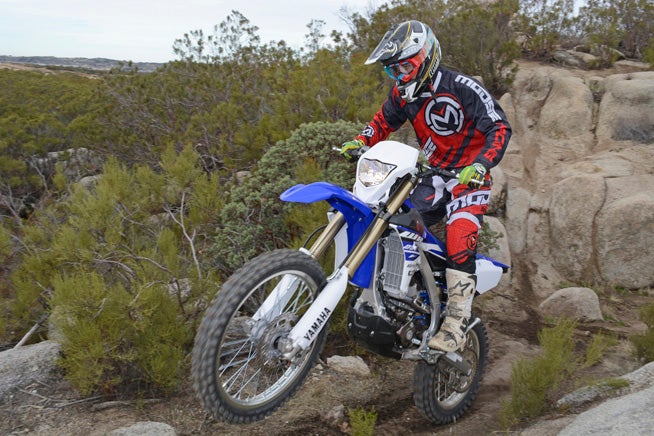
It was no surprise that Yamaha didn’t sell a new WR250F during the 2014 model year. While the tuning fork brand was very much tight-lipped about why, its fans had to figure that it was only a matter of time before a new WR250F emerged with the reversed cylinder, rearward-inclined powerplant that turned the YZ250F from a straggler into the undisputed king of the 250cc motocross class.
Well, the all-new WR250F is here, and was it ever worth the wait. The WR is so radically improved that it practically obsoletes the previous version. It truly is a YZ250F redesigned for serious off-road use.
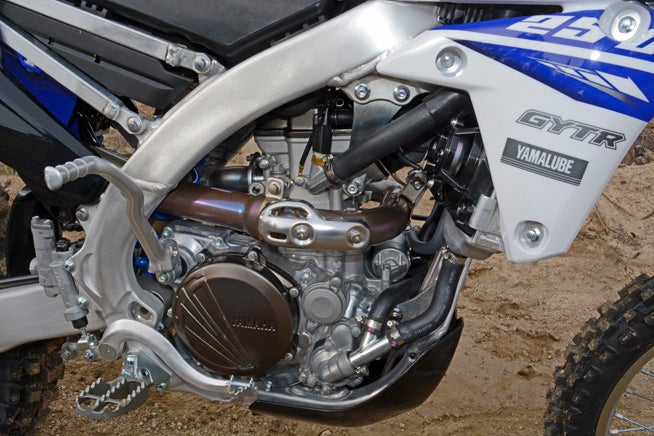
Virtually all of what makes the YZ250F so outstanding has been incorporated into the new WR. It boasts the same fuel-injected, DOHC, 249cc engine architecture, complete with the reversed cylinder head and rearward slanted cylinder. Yamaha accomplished everything that it set out to accomplish with the new engine. Reversing the head creates a straighter intake shot to the combustion chamber and allows the use of symmetrical intake and exhaust ports for more consistent port velocities when the WR’s titanium intake and exhaust valves open and close. The benefit is more efficient filling and scavenging of the combustion chamber during each revolution of the crankshaft. Also, relocating the air filter up high in the WR’s faux fuel tank helps to keep it cleaner longer, and its high position in the chassis helps to keep water from entering the airbox when water crossings are encountered.
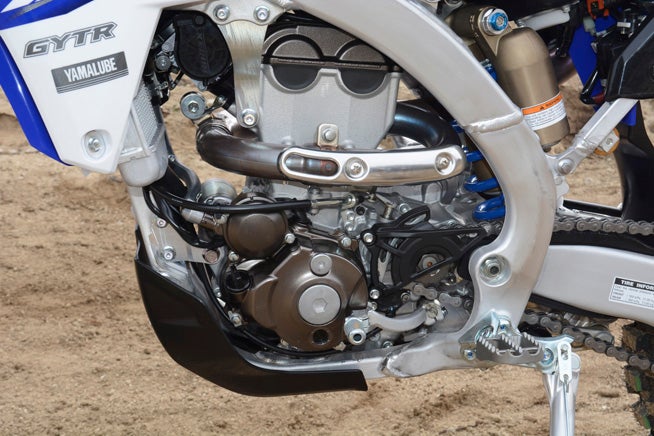
The new cylinder positioning is just as important. Inclined 6.2 degrees rearward and positioned to centralize mass by keeping the top-end mass and camshaft rotational inertia toward the center of the bike, it is also offset 3.5mm forward of the crankshaft centerline. This offset keeps the connecting rod more vertical at the moment of greatest combustion force, which lessens power-robbing drag by reducing piston-to-cylinder wall side thrust particularly at the rear of the cylinder. Less friction equals more horsepower.
Since it is basically the YZ250F in off-road trim, the WR engine also features a wet-sump oiling system, which reduces the engine’s complexity and adds to the compactness of the overall design by doing away with an external oil tank and lines. Other similarities include the same 77 mm bore and 53.6mm stroke, and the same camshaft profiles, piston design and 44mm Keihin throttle body as the YZ250F.
But there are obvious differences that give the WR its own unique identity. The WR’s engine cases, for example, are designed specifically to accommodate its convenient electric start system (there is still a kick starter fitted as a handy backup) and also to house its all-new, off-road worthy six-speed transmission, which features steeper ratios than the 2013 WR’s transmission. Less obvious is a revised clutch, which uses different clutch plate material, springs, a push lever and oil valve that are optimized for Enduro riding. The WR also has an EPA-compliant ECU that is designed to keep the WR 50-state emissions legal.
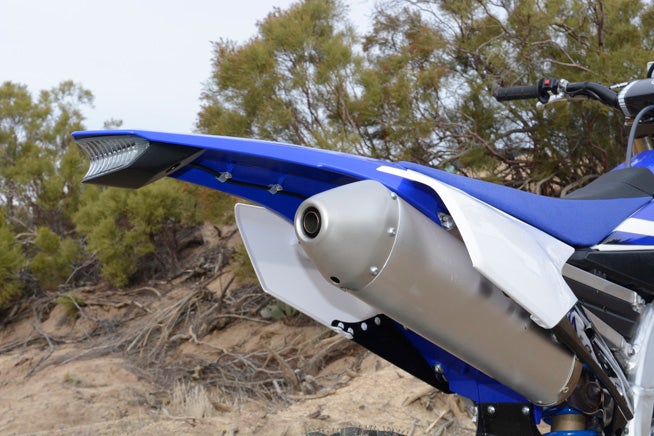
Other WR-specific features include a slightly different decompression lobe on the exhaust cam to work in concert with the electric starter, a resonator in the airbox to hush intake noise and a USFS-approved muffler/spark arrestor. There’s also an electric radiator fan to prevent overheating when riding slowly and/or in extremely hot conditions. Of course, there’s also a large-capacity generator that delivers 160 Watts at 5000 rpm to power the WR’s lights and enduro computer, and keep its onboard battery charged. The WR20F also comes with a factory-mounted plastic skid plate to protect the underside of the machine.
The WR’s all-aluminum bilateral beam chassis and removable subframe are virtually identical to the YZ250F’s. They share the same 27.08-degree rake, 118mm trail and 38.0-inch seat height. The WR’s specs quote a 57.7-inch wheelbase, which is slightly shorter than the YZ250F’s 58.1 inches, although the measurements may differ only by virtue of where their respective rear axles were positioned in the swingarm when they were measured. The only notable difference lies with the WR’s 4mm thick engine mounts, which are 2mm thinner than the YZ’s to give the chassis a less rigid feel.
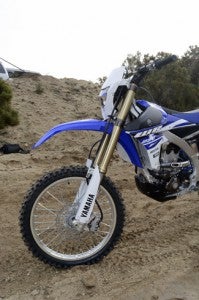 Suspension, however is one area where the motocrosser and the enduro machine differ slightly. Both feature an inverted 48mm KYB air/oil separate Speed Sensitive System spring fork with Kashima coating up front, but the WR uses enduro-oriented valving and slightly lighter, 4.4 N/mm springs compared to the YZ’s motocross valving 4.7 N/mm springs. Likewise, the WR’s KYB® rear shock, which uses a Kashima Coating to reduce stiction and features a large 50mm piston for better oil control, sports enduro valving and a softer 54 N/mm spring whereas the YZ’s spring is 56 N/mm.
Suspension, however is one area where the motocrosser and the enduro machine differ slightly. Both feature an inverted 48mm KYB air/oil separate Speed Sensitive System spring fork with Kashima coating up front, but the WR uses enduro-oriented valving and slightly lighter, 4.4 N/mm springs compared to the YZ’s motocross valving 4.7 N/mm springs. Likewise, the WR’s KYB® rear shock, which uses a Kashima Coating to reduce stiction and features a large 50mm piston for better oil control, sports enduro valving and a softer 54 N/mm spring whereas the YZ’s spring is 56 N/mm.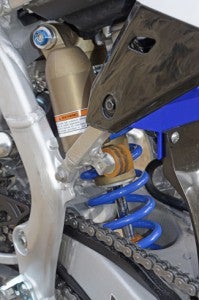
The only other obvious change is the switch to a more off-road friendly 18-inch rear wheel although Yamaha has made an interesting choice when it comes to tire fitment on the WR, opting for Dunlop’s motocross-oriented Geomax MX52 Intermediate terrain tires, going with an 80/100-21 front and 110/100-18 rear rather than with Dunlop’s signature AT81 off-road tires. Hmm.
Although Yamaha invited us to sample the WR250F at Cahuilla Creek Motocross Park, impressions were not gleaned on the moto track. Yamaha instead laid out an impressive and fun, 4-mile single-track trail loop that included loose sand mixed with rocks, small and large, drop-off ledges and big boulders. The terrain gave us a good feel for the ER’s new power and handling capabilities.
Right off the bat, we appreciate how much more hearty the new WR feels compared to the old one even though its airbox resonator and spark arrestor-equipped muffler keep the engine noise to an environmentally friendly drone. Its 10-hole fuel-injector and ECU go a long way toward eliminating the starved feel that the old carbureted WR delivered, although the engine is still a little too lean right off idle for some of our tester’s tastes, requiring the rider to keep the throttle slightly above idle when negotiating tight terrain to ensure instant throttle response and avoid the occasional hiccup and stall. Feathering the WR’s clutch helps the cause, and the clutch is plenty stout to handle the abuse. For closed-course competition, Yamaha offers a WR Race ECU that is identical to the ECU found in the new closed-course-only YZ250FX. While it does away with the WR’s emissions-compliant status, it also does away with its off-idle flat spot.
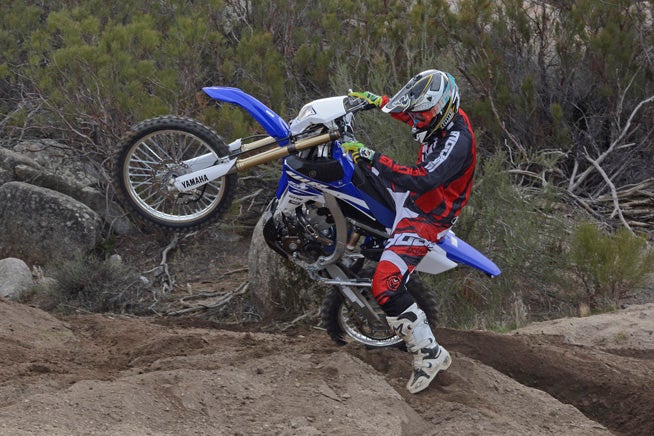
Beyond that small hiccup down low, the WR delivers ample low-end lunge and a hearty mid-range that is aggressive without compromising traction. In fact, we were impressed with just how well the WR hooked up in the loose sand and grunted over rocks on our test loop. Rowing through its clean-shifting six-speed transmission revealed excellently spaced ratios that offer the rider a choice of ratios with which to attack a nasty section. It’s no open-class monster, but the WR does have enough low-end torque and mid-range snap to allow the use of taller gears even when the going gets tight.
Even more than the engine, however, we really love the WR’s handling character, which is surprising light for a bike with a claimed 295-lb. wet weight. Thanks to the careful placement of its mass, which includes tucking its 2.0-gallon fuel cell under the seat, the WR steers with excellent precision in low or high-speed terrain without sacrificing stability, and its slim layout and excellent ergonomics allow the rider to freely move side to side as well as fore and aft as needed to maintain momentum. Our two-man test team had a blast darting through the tree sections and exploding sandy berms aboard the WR250F. That said, feedback through the stiffer sidewalls of the motocross-oriented Dunlop MX52s isn’t all that great, but the tires are just squishy enough to avoid deflecting off rocks or roots.
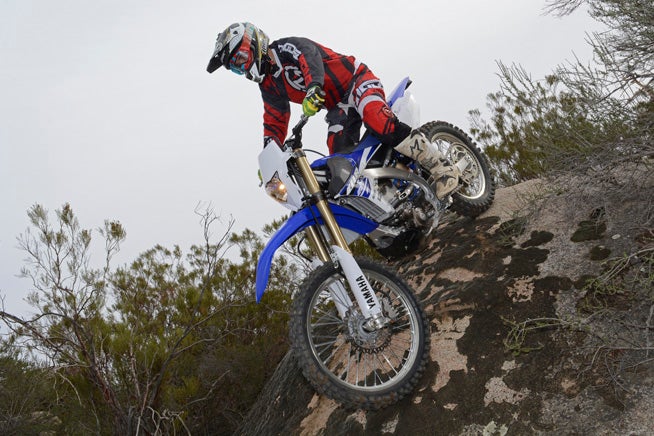
The WR’s suspension performance is very good for perhaps all but the highest-velocity desert riding. Its fork and shock were compliant at Cahuilla Creek, delivering a smooth, balanced and supple feel over rocks and tree roots, but high-speed G-outs tended to usurp the WR’s 12.2 inches of front and 12.4 inches of rear travel. If it were our bike and high-speed cross country racing was our thing, we might opt for slightly fork springs and crank some more preload into the rear end. Or we might look into Yamaha’s all-new 2015 YZ250F.
We had no complaints with the WR’s brakes for the few hours we sampled the machine, its Nissin calipers with 250mm front and 245mm rear wave rotor-style discs offer plenty of stopping power without being overly sensitive in loose terrain. We particularly liked the strong yet linear feel of the two-piston caliper up front. Riders seeking more stopping power than the WR’s brakes offer should be able to get it with a simple pad swap.
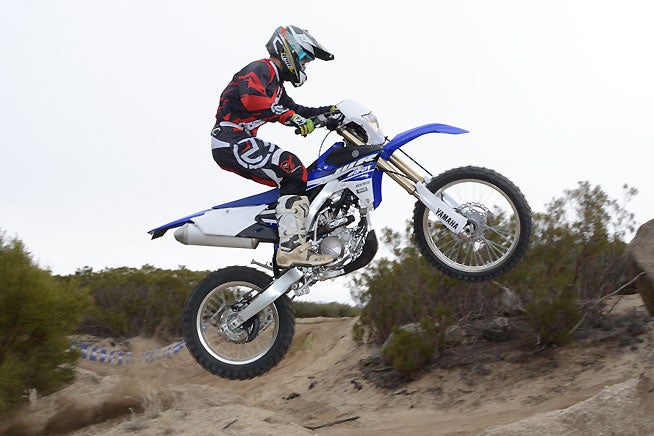
All in all, the 2015 Yamaha WR250F represents a giant step forward for Yamaha in the 250cc off-road class. Whether or not it has the goods to roost past KTM’s 250 XC-W to the top of the 250cc four-stroke off-road/enduro mountain is yet to be seen, but with an MSRP of $7990 vs. $8599 for the KTM, the Yamaha could prove to be a real value in the class either way.
We really dig the WR250F, and we think a lot of off-road riders will too.
2015 Yamaha WR250F Specifications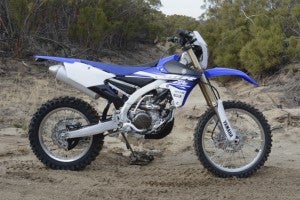
MSRP: $7990
Engine: Liquid-cooled four-stroke single, DOHC four-valve head
Displacement: 249cc
Bore x Stroke: 77.0 x 53.6mm
Horsepower: N/A
Torque: N/A
Compression Ratio: 11.8:1
Fuel System: Keihin EFI, 44m throttle body
Ignition: TCI
Transmission: Six-speed
Final Drive: Chain
Frame type: Bilateral beam aluminum
Front Suspension: Inverted KYB fully adj. fork w/Speed Sensitive System; 12.2 in. of travel
Rear Suspension: KYB fully adjustable monoshock w/piggyback reservoir, 50mm piston; 12.4 in. of travel
Front Brake: Nissin two-piston caliper 250mm wave-style disc
Rear Brake: Nissin single-piston caliper 245mm wave-style disc
Front Tire: Dunlop Geomax MX52 80/100-21
Rear Tire: Dunlop Geomax MX52 110/100-18
Wheelbase: 57.7 in.
Rake: 27°08´
Trail: 118mm
Seat Height: 38.0 in.
Ground Clearance: 12.8 in.
Wet Weight: 295 lbs. (claimed)
Fuel Capacity: 2.0 gal.
Color: Blue & White
 Your Privacy Choices
Your Privacy Choices